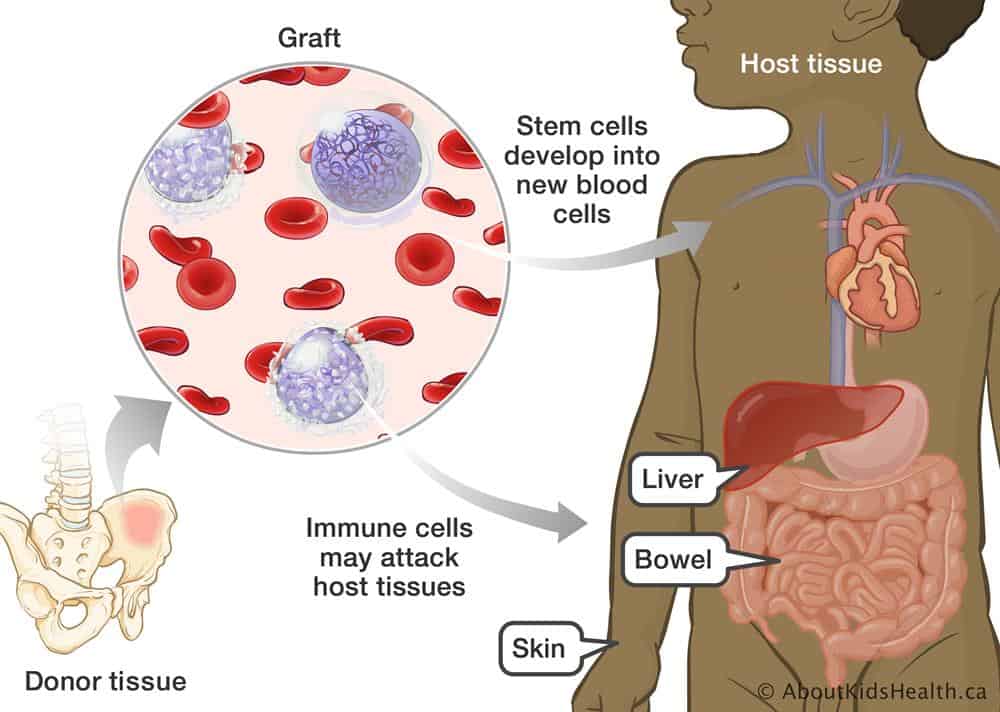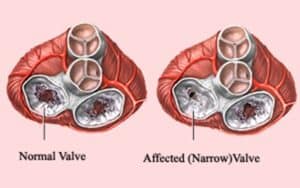Graft-versus-host disease (GVHD) is a potentially fatal complication that can arise following certain stem cell or bone marrow transplants. Before a transplant, tissue and cells from potential donors are evaluated for their similarity to the recipient. When the match is near, GVHD is less likely to occur, or symptoms will be milder. GVHD is observed in the following situations:
- Following allogeneic bone transplantation (most common)
- Following transplantation of solid organs that are abundant in lymphoid cells, immunosuppression is observed (e.g. liver)
- Following transfusion of un-irradiated blood
Types of GVHD
GVHD can be divided into two types:
- Acute GVHD
- Chronic GVHD
Acute GVHD
This typically occurs within the first 100 days following transplantation, although it might occur later. Acute GVHD can impact the skin, digestive system, and liver. Symptoms may include of
- A rash accompanied by itching and redness of the skin. This may manifest on the palms or soles of the patient’s feet and frequently affects the trunk and other extremities as well. In extreme instances of GVHD, the skin’s exposed surface may flake off.
- Nausea, vomiting, abdominal cramps, appetite loss, and diarrhea indicate gastrointestinal involvement.
- Jaundice (yellowing of the skin or eyes) may indicate liver damage caused by GVHD. Blood test findings would reveal any abnormalities in liver function.
Many individuals with acute GVHD are successfully treated with corticosteroids that increase immunosuppression (medicines such as prednisone, methylprednisolone, dexamethasone, beclomethasone and budesonide).
Chronic GHVD (cGVHD):
The chronic form of graft-versus-host disease (cGVHD) often manifests between 90 and 600 days after transplant. Moderate to severe cases of chronic graft-versus-host disease have a negative impact on long-term survival.
Commonly, the initial sign of cGVHD is a rash on the palms of the hands or the soles of the feet, which can spread and is typically itchy and dry. In extreme instances, the skin may blister and peel, similar to a severe sunburn. Moreover, a fever may develop. Other persistent GVHD symptoms may include:
- A diminished appetite
- Diarrhea
- Abdominal cramps or pain
- Weight loss
- discoloration of the skin and eyes
- Enlarged liver
- Bloated abdomen
- Abdominal pain in the upper right quadrant (belly)
- Elevated liver enzyme levels in the blood (seen on blood tests)
- Skin tightness
- A sense of dryness and burning in the eyes
- Dry mouth or painful mouth ulcers
- Sensations of burning when consuming acidic foods
- Bacterial diseases
- Obstructions in the smaller pulmonary airways
Chronic graft-versus-host disease presents in the oral cavity as lichen planus with a higher probability of malignant progression to oral squamous cell carcinoma than classical oral lichen planus. Mouth cancer in patients with graft-versus-host disease may be more aggressive and have a worse prognosis than oral cancer in people with non-hematopoietic stem cell transplantation.

Diagnosis
GvHD can be difficult to identify because many of its symptoms are shared with other disorders or diseases that are unrelated to GvHD. A person with GvHD who is treated presumptively without meeting specified diagnostic criteria may be exposed to medicines that are not only useless but may also disguise the true source of the symptoms.
However, medical professionals diagnose this disease by:
- An accurate medical history and physical assessment (The area over the graft may be painful)
- Biopsy of the transplanted organ
- Blood cell count and ESR
- Acute biomarkers
- Test of liver function
- Test of renal function
- Endoscopy
- Imaging investigations e.g., CT scan, MRI
Treatment of acute GVHD
First line treatment
Typically, methylprednisolone or prednisone administered intravenously or orally is the initial treatment for acute GVHD. Patients are often administered a steroid dosage between 0.50 and 2 mg/kg. If the patient is responding, the dosage is decreased gradually over time. If the patient does not respond to steroid treatment within three to five days, the patient is deemed steroid-refractory, and alternative treatments must be considered.
Second line treatment
Cases of acute GVHD resistant to steroids are considerably more difficult to treat. Historically, there have been numerous second-line medicines with shown efficacy. However, none of these treatments have demonstrated success in randomized, multicenter clinical trials.
In 2019, however, the Janus kinase1/2 inhibitor ruxolitinib was authorized for the treatment of acute GVHD. Randomized research published in NEJM in 2020 comparing ruxolitinib to the best available therapy demonstrated a clear benefit for ruxolitinib, both in terms of overall response and response durability. Ruxolitinib is currently FDA-approved for the treatment of acute GVHD in second-line settings.
Treatment of chronic GVHD
Steroids are frequently used to treat persistent GvHD. You may also be prescribed ciclosporin (also known as Deximune, Neoral, or Sandimmum) to suppress your immune response.
If these medications fail to control the GvHD, your doctor may recommend more immunosuppressive therapy. Some of these therapies rely on the damaged area of the body.
- Therapies include:
- Tacrolimus
- Sirolimus
- Pentostatin
- Rituximab
- Imatinib
- Dasatinib
- The drug Mycophenolate mofetil
- An exclusive form of light therapy known as extracorporeal photopheresis
- Ibrutinib
- Ruxolitinib



